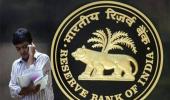'I hope the trend is sustainable and that economic activity accelerates going forward.'

Interest rates will remain benign for some time as capacity utilisation remains low, but the economy is showing definite signs of improvement and revival in corporate credit demand can be expected in four-six months, State Bank of India Chairman Dinesh Kumar Khara tells Business Standard's Abhijit Lele and Anup Roy in a freewheeling interview.
The banking system is awaiting a proposal for restructuring, if at all, from Vodafone-Idea and there is no major surprise in terms of asset quality, Khara said ahead of the annual SBI Banking and Economics Conclave on November 16-17, of which Business Standard was the exclusive print partner.
Conferences are held virtually these days, but the country's largest bank is holding a physical event. It almost feels like a statement. Why not a virtual summit?
We are quite cognisant of the health emergency seen since March 2020, and it requires a whole lot of precautions.
But we also acknowledge the fact that over 1.11 billion population has been vaccinated.
Of that, 80 per cent of eligible adults have already received the first dose, and 38 per cent, the second.
We are trying to put up a demonstrative statement, a small recognition of the resilience of India as a nation, that things are coming back to normal.
However, while making the statement, we are quite aware that we should follow all protocols required at this point.
In this backdrop, what is your assessment of the economy, and what does resilience mean for credit offtake?
We have seen a definite improvement in economic activity in October.
There has been a lot of traction, a significant improvement in monthly cargo and port cargo traffic.
Government revenue collections, GST collections -- they're all at a record high in October, even the monsoons have been good and we expect a record kharif harvest.
If we can read the signs, October shows a definite improvement in the corporate cycle.
As far as the bank is concerned, out credit-deposit ratio improved by two per cent in October itself.
I hope the trend is sustainable and that economic activity accelerates going forward.
With the new capex cycle indicators gaining ground, in what way can banks avoid past mistakes of, say, the 2008-2013 period, which created a lot of pain and bad debts piled up in the system in the subsequent years?
There were definite lessons from the 2008-2013 period, which all banks have picked up and they have strengthened their underwriting practices based on the root cause analysis.
Deficiencies were addressed, and by now, adequate provisioning has been done by all banks.
The provision coverage ratio for all the banks would be at least 70 per cent plus.
The lessons incorporated into the system have strengthened all the banks, and perhaps the strength of the balance sheet.
Improvement in the underwriting practices goes a long way in mitigating the future risks.
There is also a definite change in the ecosystem.
We have seen that the Insolvency and Bankruptcy Code has made borrowers quite responsible.
New opportunities are emerging post corporate deleveraging.
The performance-linked incentive (PLI) schemes, guaranteed emergency credit line (GECL) etc have actually built the confidence of bankers as well.
In the last cycle, when SBI cleared a particular loan or project finance proposal for a big corporate, the other banks blindly followed it. So, what exactly would your message be to peers and fellow bankers as we start the new cycle?
When we do any appraisal, we evaluate the project in line with our own risk appetite, our assessment about the risk inherent in the proposal, and our ability to mitigate those risks.
It is something which is very local to our balance sheet and our perception of the risk.
In a consortium, or a vertical banking arrangement, whenever any such a proposal or covenant is shared, there is invariably a caveat that this is something which gives a broad picture in terms of all the risk assessed.
But it has to be seen in the context of the risk appetite of the bank that is underwriting the particular proposal.
Not all kinds of risks would be suited for all kinds of balance sheets.
Lenders should evaluate the overall proposal in the context of their own policies, and also in their understanding of where the risk lies.

Banks are relying on retail credit for growth, but even the RBI governor has warned that they should not overreach. Wholesale credit, however, is not picking up. What's your assessment?
Retail credit growth has to be seen in the context of available opportunity.
Considering that there is elbow room to leverage the additional balance sheets, there is a scope for retail lending.
Having said that, one must be mindful of the safety margin available, and the certainty of that safety margin.
Second, a very important factor is how effective the collection machinery is.
In retail, it matters all the more because it is all spread out quite a lot.
I think all banks that are betting on retail credit look at the loan to value ratio.
And they are quite conversant with appraising the value in a very scientific manner.
I'd say they have really strengthened their underwriting practices and have leveraged structured and unstructured data available in the ecosystem to improve these practices.
As for corporate credit, it is a function of the capacity utilisation.
The improvement in the CD ratio in October very clearly means there is more demand and traction from the corporates as well.
If this trend sustains, I'm sure it will lead to working capital utilisation.
And beyond a stage, investment demand will come in, which will open up the opportunity for the term loans to be taken from the banking system.
If this demand trend sustains, in terms of an optimistic timeline, we can expect four to six months for a meaningful credit offtake from the corporate side.
As of now, the credit-deposit ratio for the system as a whole is somewhere around 59 per cent. There is a huge scope for improvement.
Which are the sectors you are seeing the credit demand coming from, now and in the immediate future?
As of now, we have seen credit demand coming from the commodity sector.
We have started seeing opportunities in the auto sector, and the commercial real estate as well as the logistics sectors.
These sectors are showing definite traction for credit to grow.
As we move forward, we expect an opportunity in engineering sector, chemicals, food processing, and infrastructure.
We have seen some kind of growth in exports, especially textiles.
The pharmaceutical sector is also showing good promise, but generally, the pharma sector is not borrowing much from the banking system.
But yes, it will certainly contribute as a GDP growth component.
We hope at some stage the banking system would have an opportunity to support the pharma sector.
Personal loans will continue to grow. At our bank, on a three-year CAGR basis, personal loans have grown 16 per cent.
I hope this demand revival will be led by the personal demand, which will eventually translate into personal loans going well.
Real estate sector is back, and housing will be a major sector for growth.
Interest rates may harden now. Do you expect retail loan demand to fall in that case? Will it lead to NPAs because banks have lent so aggressively to retail?
When it comes to housing, interest rates matter, but perhaps over-dependence on the interest rate is not there.
Even if rates go up, I don't think we will see a rapid increase.
Rate increase will likely be marginal because capacity utilisation is low in the economy.
It will take some time for capacity utilisation to increase for the demand for credit to recover.
To my mind, it is likely to be a benign interest rate environment for some more time to go.
In the past, we have seen interest rates as a component of the overall expenses for the corporate sector is not very significant.
So, an interest rate hike will not have an overbearing impact on the housing or the corporate sector.
Feature Presentation: Aslam Hunani/Rediff.com











